-
 Afrikaans
Afrikaans -
 Albanian
Albanian -
 Amharic
Amharic -
 Arabic
Arabic -
 Armenian
Armenian -
 Azerbaijani
Azerbaijani -
 Basque
Basque -
 Belarusian
Belarusian -
 Bengali
Bengali -
 Bosnian
Bosnian -
 Bulgarian
Bulgarian -
 Catalan
Catalan -
 Cebuano
Cebuano -
 China
China -
 Corsican
Corsican -
 Croatian
Croatian -
 Czech
Czech -
 Danish
Danish -
 Dutch
Dutch -
 English
English -
 Esperanto
Esperanto -
 Estonian
Estonian -
 Finnish
Finnish -
 French
French -
 Frisian
Frisian -
 Galician
Galician -
 Georgian
Georgian -
 German
German -
 Greek
Greek -
 Gujarati
Gujarati -
 Haitian Creole
Haitian Creole -
 hausa
hausa -
 hawaiian
hawaiian -
 Hebrew
Hebrew -
 Hindi
Hindi -
 Miao
Miao -
 Hungarian
Hungarian -
 Icelandic
Icelandic -
 igbo
igbo -
 Indonesian
Indonesian -
 irish
irish -
 Italian
Italian -
 Japanese
Japanese -
 Javanese
Javanese -
 Kannada
Kannada -
 kazakh
kazakh -
 Khmer
Khmer -
 Rwandese
Rwandese -
 Korean
Korean -
 Kurdish
Kurdish -
 Kyrgyz
Kyrgyz -
 Lao
Lao -
 Latin
Latin -
 Latvian
Latvian -
 Lithuanian
Lithuanian -
 Luxembourgish
Luxembourgish -
 Macedonian
Macedonian -
 Malgashi
Malgashi -
 Malay
Malay -
 Malayalam
Malayalam -
 Maltese
Maltese -
 Maori
Maori -
 Marathi
Marathi -
 Mongolian
Mongolian -
 Myanmar
Myanmar -
 Nepali
Nepali -
 Norwegian
Norwegian -
 Norwegian
Norwegian -
 Occitan
Occitan -
 Pashto
Pashto -
 Persian
Persian -
 Polish
Polish -
 Portuguese
Portuguese -
 Punjabi
Punjabi -
 Romanian
Romanian -
 Russian
Russian -
 Samoan
Samoan -
 Scottish Gaelic
Scottish Gaelic -
 Serbian
Serbian -
 Sesotho
Sesotho -
 Shona
Shona -
 Sindhi
Sindhi -
 Sinhala
Sinhala -
 Slovak
Slovak -
 Slovenian
Slovenian -
 Somali
Somali -
 Spanish
Spanish -
 Sundanese
Sundanese -
 Swahili
Swahili -
 Swedish
Swedish -
 Tagalog
Tagalog -
 Tajik
Tajik -
 Tamil
Tamil -
 Tatar
Tatar -
 Telugu
Telugu -
 Thai
Thai -
 Turkish
Turkish -
 Turkmen
Turkmen -
 Ukrainian
Ukrainian -
 Urdu
Urdu -
 Uighur
Uighur -
 Uzbek
Uzbek -
 Vietnamese
Vietnamese -
 Welsh
Welsh -
 Bantu
Bantu -
 Yiddish
Yiddish -
 Yoruba
Yoruba -
 Zulu
Zulu
Exploring the Benefits and Uses of HDPE and PP Bags for Packaging Solutions
The Significance of HDPE and PP Bags in Modern Packaging
In recent years, the evolution of packaging materials has taken center stage, especially with the rising demand for sustainable and efficient options. Among these, High-Density Polyethylene (HDPE) and Polypropylene (PP) bags have emerged as popular choices for various applications in both consumer and industrial markets. These materials offer several advantages, making them increasingly relevant in today's environmentally conscious society.
Understanding HDPE and PP Bags
HDPE bags are made from high-density polyethylene, a thermoplastic polymer that is known for its durability and strength. These bags are commonly used for grocery shopping, retail packaging, and even in agricultural applications. Their resistance to moisture and chemicals makes them suitable for holding a wide range of products, from food items to laundry.
On the other hand, PP bags are made from polypropylene, another type of thermoplastic. These bags are slightly more flexible than HDPE bags and are commonly used for packaging bulk materials, such as grains, feeds, and chemicals. PP bags are known for their clarity, which allows for easy inspection of the contents, and they can be designed for both lightweight and heavy-duty applications.
Environmental Impact and Recyclability
One of the greatest challenges facing the packaging industry today is the environmental impact of plastic waste. However, both HDPE and PP bags have shown commendable levels of recyclability. Many municipalities and recycling centers accept HDPE and PP products, which can be reprocessed into new materials, thus reducing the demand for virgin plastics. Initiatives such as waste segregation and recycling programs are crucial in encouraging responsible disposal practices among consumers.
hdpe pp bags

Moreover, manufacturers are increasingly adopting eco-friendly production methods and promoting the use of more sustainable materials. This shift not only reduces the carbon footprint associated with plastic production but also aligns with the preferences of consumers who are opting for eco-conscious brands.
Versatility and Practicality
The versatility of HDPE and PP bags cannot be overstated. These bags can be produced in various sizes, colors, and styles to meet diverse packaging needs. From shopping bags to industrial sacks, their adaptability is one key reason why they remain a staple in various sectors.
Additionally, both types of bags are lightweight, reducing transportation costs, which is a significant factor for businesses. Their strength and resistance to tearing ensure that products remain protected during transit and storage.
Conclusion
In conclusion, HDPE and PP bags play a crucial role in modern packaging solutions. As society moves towards more sustainable practices, these materials are finding their place in a greener future. Their recyclability, versatility, and practicality make them indispensable in both everyday consumer markets and industrial applications. By promoting responsible use and recycling initiatives, we can contribute to a more sustainable world while enjoying the benefits that HDPE and PP bags have to offer.
-
Shipping Plastic Bags for Every NeedNewsJul.24,2025
-
Safety Netting: Your Shield in ConstructionNewsJul.24,2025
-
Plastic Mesh Netting for Everyday UseNewsJul.24,2025
-
Nylon Netting for Every UseNewsJul.24,2025
-
Mesh Breeder Box for Fish TanksNewsJul.24,2025
-
Expanded Steel Mesh Offers Durable VersatilityNewsJul.24,2025











